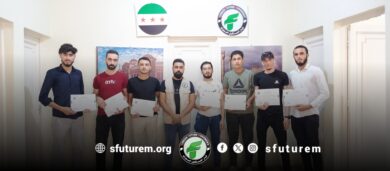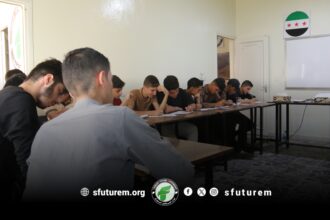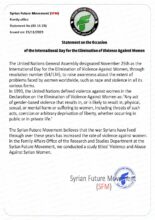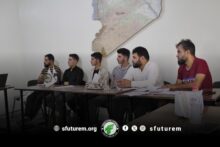Child Exploitation in Wars: Challenges and Recommendations

Introduction:
Historically, children have been used in armed conflicts in various ways, whether as soldiers, human shields, or in supportive roles like spies or porters. Humanity eventually reached a level of awareness that recognized the sanctity of childhood, leading to the establishment of binding rights-based laws to protect children, obligating states and political and military actors to comply. Yet, remnants of primitive and outdated mentalities persist, as seen in the exploitation of children in wars—a grave issue that needs to be highlighted to show that Syria is not isolated from this tragic reality. We aim, alongside the world’s wise voices, to raise awareness of human rights and combat all regressive efforts.
During the Middle Ages and the Napoleonic Wars, children were directly used in battles. In the American Civil War, for instance, children took part in the Battle of New Market in Virginia in 1864. Similarly, in Nazi Germany, the “Hitler Youth” were trained for combat and involved in military operations. The exploitation of children in armed conflicts continued into the 20th and early 21st centuries, particularly in regions such as Africa, Latin America, and the Middle East.
Impact on Children:
Children exploited in wars suffer severe psychological and physical consequences. The 1996 United Nations report on the impact of armed conflict on children revealed that such children are at risk of psychological disorders, literacy challenges, and aggressive behaviors. Child soldiers often face lifelong poverty and unemployment upon reaching adulthood, along with the risk of torture and maltreatment during captivity by armed forces.
Global efforts to reduce child exploitation in armed conflicts began at the start of the new millennium. These efforts include strengthening international laws and providing psychological and social support to affected children.
The Exploitation of Children in Syria:
The exploitation of children in Syria is a severe and ongoing issue since the beginning of the conflict. According to reports from the United Nations and human rights organizations, this exploitation has several aspects:
- Forced Recruitment: Over 5,700 children have been recruited to fight, some as young as seven years old. These children are used in direct combat roles and supporting roles, such as spies or porters.
- Forced Labor: Due to economic hardship and extreme poverty, many children are compelled to work in harsh and dangerous conditions to help support their families.
- Psychological Impact: Children experience severe psychological and social effects from continuous exposure to violence, fear, and trauma. Studies show that a large percentage of these children suffer from psychological disorders as a result.
- Education: Approximately 2.45 million children in Syria, along with an additional 750,000 Syrian children in neighboring countries, are out of school, which significantly impacts their future opportunities in life.
- Malnutrition: More than half a million children under the age of five in Syria suffer from stunted growth due to chronic malnutrition, which affects their physical and mental development.
These conditions reflect the profound impact of the conflict on children in Syria, highlighting the urgent need to provide humanitarian, psychological, and social support for them.
Efforts Made:
Significant efforts are being made internationally to prevent the exploitation of children in wars and to protect them from violations. Some key efforts include:
- International Laws and Agreements, such as:
- A. The Optional Protocol to the Convention on the Rights of the Child on the Involvement of Children in Armed Conflict (OPAC) prohibits the recruitment of children under 18 years of age into armed forces and emphasizes the protection of children from participation in armed conflicts.
- B. The Convention on the Rights of the Child provides comprehensive protection for children, including safeguarding them from exploitation in armed conflicts.
- The efforts of the United Nations, through:
- A. UNICEF works to provide psychological and social support to children affected by conflicts, offering education and healthcare, and advocating for an end to attacks on schools, hospitals, and critical infrastructure for children.
- B. The United Nations Security Council has issued several resolutions condemning serious violations against children in armed conflicts, such as Resolution 2427, which calls for the reintegration of recruited children and the provision of healthcare and psychological support for them.
- Non-governmental organizations, including:
- A. Save the Children works to protect children from recruitment and provides psychological and social support for them, in addition to offering education and healthcare in conflict areas.
- B. Human Rights Watch documents violations against children and pressures governments and armed groups to stop the recruitment and use of children in conflicts.
- Awareness and advocacy, such as:
- A. International Day Against the Use of Child Soldiers is celebrated on February 12 each year to raise awareness about the issue of child recruitment and to call for an end to this practice.
- B. Awareness campaigns, where international and local organizations conduct campaigns to raise awareness about children’s rights and the importance of protecting them from exploitation in armed conflicts.
- Legal accountability, through:
- A. The International Criminal Court works to prosecute individuals and groups involved in the recruitment and use of children in armed conflicts, contributing to deterring these practices.
- B. These efforts reflect the international community’s commitment to protecting children from exploitation in wars and ensuring their rights in a safe and stable environment.\
Challenges:
Efforts to address the effects of war on children in Syria face significant and complex challenges that require comprehensive and long-term solutions. Some of the most important challenges include:
- Ongoing Conflict: The continuation of military conflict in Syria poses the greatest obstacle to providing humanitarian aid and protecting children, who are continuously exposed to danger, violence, and displacement.
- Access to Besieged Areas: Difficulty in reaching besieged and remote areas, where children urgently need assistance due to blockades and restrictions on humanitarian aid access.
- Funding Shortages: There remains a significant gap in the funding needed to meet the massive humanitarian needs in Syria, negatively impacting the delivery of essential services to children.
- Displacement: The internal and external displacement of millions of Syrians has led to family breakdown and increased suffering for children, who face difficulties accessing education and healthcare.
- Landmines and Explosive Devices: Landmines and explosive devices pose a significant threat to children’s lives, as they risk injury or death while playing or searching for sources of livelihood.
- Forced Recruitment: The recruitment of children by armed groups represents a major threat to their future, depriving them of their childhood and exposing them to violence and exploitation.
- Psychological Trauma: Syrian children suffer from deep psychological trauma due to the violence and wars they have witnessed, necessitating specialized mental health care programs.
- Lack of Infrastructure: The destruction of infrastructure in Syria, including schools and hospitals, makes it difficult to provide basic services to children.
- Climate Change: Climate change exacerbates the crisis in Syria, affecting agriculture and water resources, leading to increased malnutrition and poverty.
- Political Interventions: Complex external political interventions in the Syrian conflict hinder efforts to find a political solution and negatively impact the lives of civilians, including children.
It can be said that protecting Syrian children is a collective responsibility that requires concerted efforts at all levels.
Conclusion:
Unfortunately, the exploitation of children in Syria is an ongoing issue since the beginning of the conflict. These conditions reflect the extent of the impact of the conflict on children in Syria, highlighting the urgent need to provide humanitarian, psychological, and social support for them.
The war in Syria is considered one of the most severe humanitarian crises in modern times, leaving profound effects on Syrian children who have faced violence, displacement, and deprivation of their basic rights. To protect these children, a series of urgent and long-term measures must be taken, which we recommend in the Family Affairs Office of the Syrian Future Movement:
- Ceasefire: This is done through ongoing calls for a ceasefire and pressure on all conflicting parties to immediately and permanently halt hostilities and protect civilians, especially children.
- And providing safe corridors by facilitating the movement of civilians, including children, to safe areas and providing humanitarian corridors for delivering aid.
- Protection from violence: by preventing the recruitment of children, taking strict measures to prevent the recruitment of children in the armed forces and armed groups, and providing programs for the reintegration of recruited children.
- In addition to providing mental health services for children who have experienced the trauma of war, and training teachers and educators to handle these cases.
- Guaranteeing the right to education: by rebuilding schools that were destroyed due to the war and providing educational materials and textbooks.
- With the necessity of ensuring that schools are not used for military purposes and protecting them from attacks.
- Providing basic services: by ensuring that humanitarian assistance reaches all affected areas, including food, medicine, clean water, and shelter. In addition to providing primary and secondary healthcare for children, including vaccinations and regular medical check-ups.
- Protecting children: from exploitation by taking strict measures to combat child trafficking and exploitation. Preventing child labor in hazardous or harmful jobs, and providing safe job opportunities for children who have been forced to work.
- Resettling refugees: by providing programs for the resettlement of Syrian refugees in other countries and facilitating asylum procedures.
- In addition to supporting reconstruction programs in Syria to enable refugees to return to their homes.
- Accountability: through holding accountable those responsible for crimes committed against children, such as murder, torture, and rape.
- And supporting transitional justice programs to assist in national reconciliation and rebuilding trust.
The protection of Syrian children is a shared responsibility that falls on the international community, the de facto authorities in Syria, and humanitarian organizations. By implementing these recommendations, we can contribute to building a better future for Syrian children and enable them to recover from the effects of war.
It should be noted that these efforts must be part of a comprehensive political solution to the Syrian crisis.
These efforts should also include enhancing the role of women in Syrian society and empowering them to participate in the rebuilding process.
There must be close coordination among all concerned stakeholders to protect children.
Office of Family Affairs
Afra Al-Haddad
Research and Studies Department
Studies
Syrian Future Movement
References:
- On the International Day Against the Use of Child Soldiers, a call to end recruitment.
- UNICEF’s Agenda for Change to Protect Children in Armed Conflicts.
- Five Things We Need to Know About Children and Armed Conflict.
- After 10 years of conflict in Syria: 90% of children are in need of support.
- The number of children in need in Syria is greater than ever after 13 years of conflict.
- Children of Syria – Human Rights Watch.
- International Report: Syrian Children Pay a Heavy Price for the World’s Failure to End the Conflict.
- Translating Hope into Action: 25 Years of Protecting Children from the Impacts of Conflict.






